I N T E R V I E W
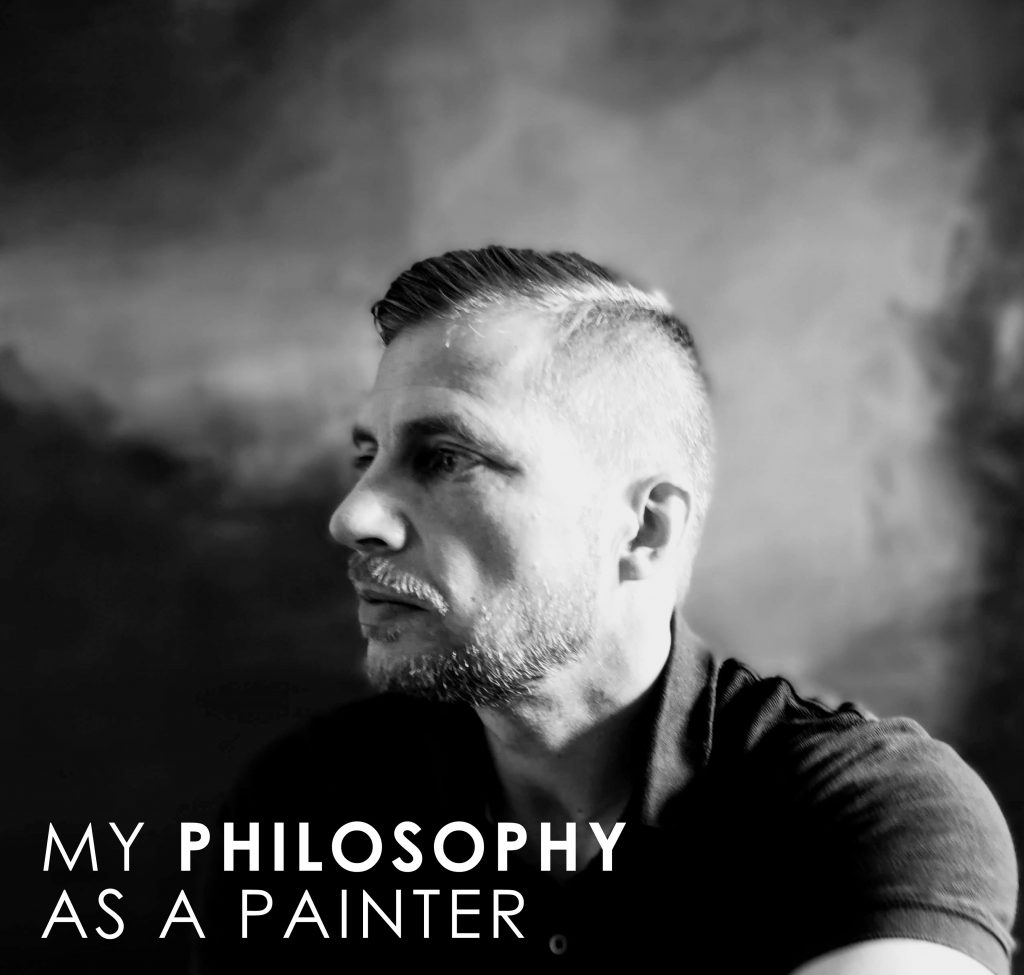
P A I N T I N G P H I L O S O P H Y
WHY I PAINT. WHAT I PAINT FOR.
HOW I PAINT. WHAT I PAINT.
It’s more than the canvas and its colors and lines. Contemporary abstract expressionism, as I understand it: the ideas behind the painting and the search for the essence. I’m a seeker as a painter, I’m looking for answers. The single human stands in the focus. Not every small detail needs an explanation, but it’s important to me to expound the serious formal background of my paintings as well as my vision, my thoughts and the concept behind my art. Of course it is subjective. It also works beyond brush and stroke. Summarized: my philosophy as a painter.
Below you will find the transcript of a very detailed interview that I conducted with editors of a German art magazine in the fall of 2019. I am convinced that this interview clarifies my point of view and my artistic goals. You can also open/download this interview as a PDF document:
> INTERVIEW: MY PAINTING PHILOSOPHY (PDF)
originally in German, translated into English
WHERE THERE IS LIGHT
AN INTERVIEW WITH THE PAINTER CHRISTIAN BAHR
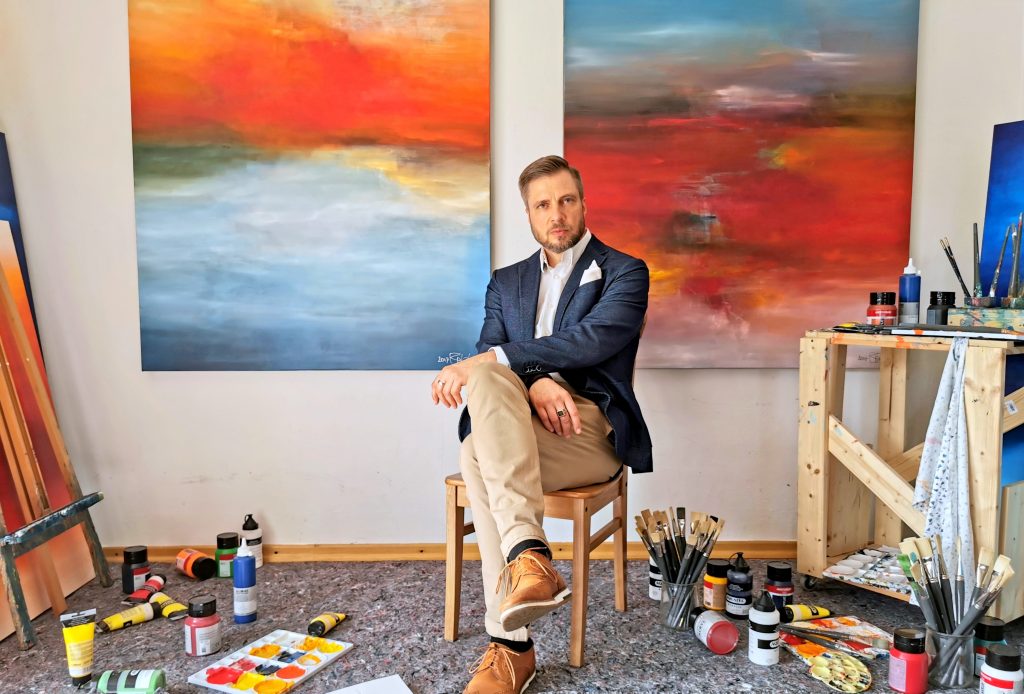
* * * * * *
He is one of the most poetic and profound contemporary German painters as well as an experienced graphic artist. His abstract, large format works can be found in private collections and public spaces in the USA and Canada, Australia, Great Britain, China and others. Intensive symbolism along with strict aesthetics characterize his reduced and powerful paintings. We asked Christian Bahr for an interview and soon noticed that here is a painter who has much to tell about his work. An artist with a clear philosophy and high expectations for himself and his paintings.
* *
You have been painting and drawing for over 35 years. What does painting mean to you?
Painting and life are inseparable and belong together. I am a human and an artist in only one persona. I paint what I see and feel as a human. My painting helps me to understand the world within and around me in a better way, allowing me to develop new perspectives. That’s why I love painting. Every sensation that I feel, every thought that I carry in me, is both within life and painting. There is no need to artificially construct anything on a canvas – it all comes naturally. Everything is obvious, original, natural – it all belongs together and influences each other. That’s how painting must be. Thrown in the middle of life, turned to the people. We deprive ourselves from the power and mystique of art: as if we want to preserve it as an untouchable treasure and keep it out of everything.
So life itself is your artistic reference?
Real life is the best teacher and inspiration, any kind of study can only be an academic start and remains only a theory. But I do not want to talk about tiring theories. Art is so much more for me. I want to feel the painting, I want to breathe it, and my emotions and my intellect long to be touched and impressed by it. Because for me, art is the real, true beauty of mankind, with painting being a significant part of art. Painting beautifies our daily life. I refer to a wonderful quote from Fyodor Dostoyevsky: Only beauty can save this world. I believe that as an artist and as a human being. I believe in the power of beauty. Painting should create hope and be hope. A place where there is uncorrupted light.
How does your creative process develop and how do you get from the idea to the finished painting?
My paintings are created intuitively and directly. Approaches, colors, and shapes are born at the moment. As a result of the dominant sensation in me that comes along the way, makes itself heard, and urges me for an immediate implementation. It must be as distance-free as possible and without extensive drafts. Not a constructed mind game but rather an emotional rough, melancholic, and heavy yet at the same time bright, poetic and hopeful mind game. No maybe, no lukewarm. Every single moment counts during the execution, remains important and can lead to a major change of direction. I always remain vigilant. I do not sacrifice the line for the idea, and I enjoy the permanent creative risk at work, the radical nature of the decisions to make during the process. I paint and draw only in this way and not otherwise. I do not want to show the unimportant in my paintings, because the unimportant and triviality is just decoration, a deceptive and pleasing accessory that distracts from the core and from my message. No detours, no beautiful facades. I deny the unimportant without any ifs and buts. Even though the decision is not always easy to make, since the unimportant sometimes cleverly camouflages as an important part of the painting. I remove the unimportant from the canvas without residues. It is a dialogue with me. I want it focused on the core, reduced to the essence. Everything else is a betrayal to the statement of the painting.
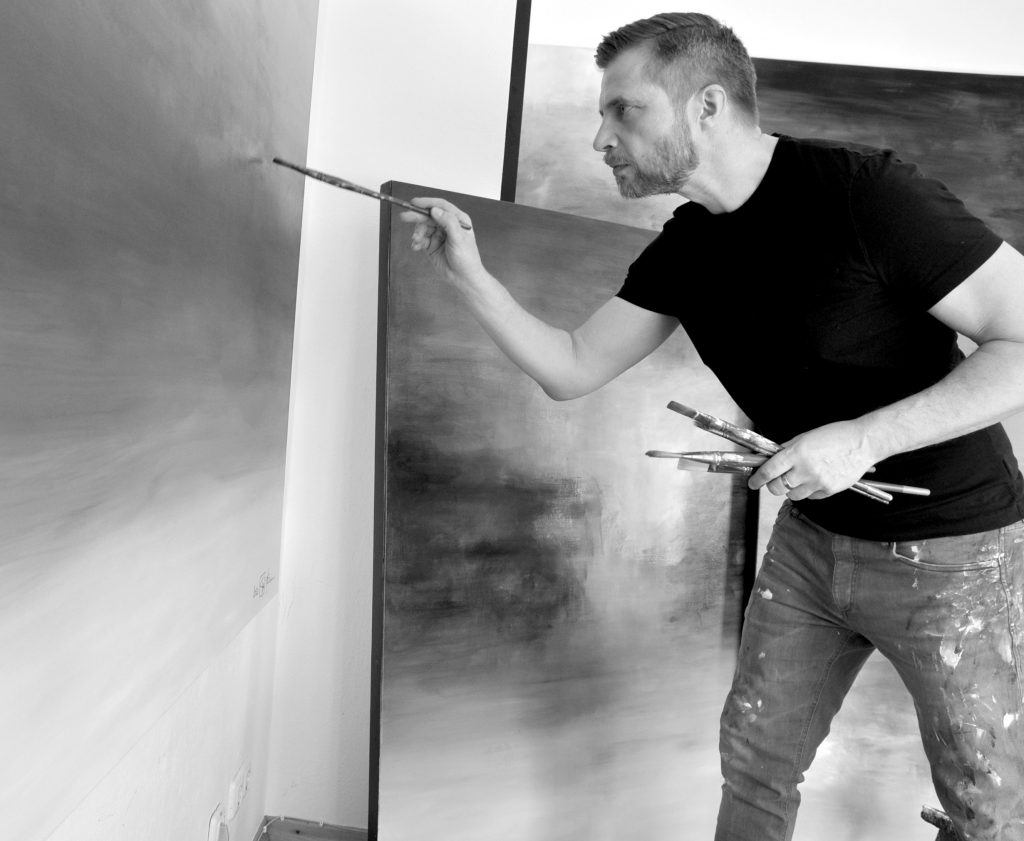
»EVERY SUCCESSFUL PAINTING IS BOTH A LIE AND A TRUTH.«
* * * * * *
Has the nature of your abstraction changed over the years?
The older I get, the clearer my view becomes. I communicate better with the canvas, I recognize misleading ways sooner, and I do not give up my paintings as quickly as I used to. Nevertheless, I am more radical than before. Sometimes I am really brutal in dealing with my art, in what I consider to be viable and in what I reject. It’s not always a harmonic process, often it turns into a fight. A productive and necessary conflict in me.
When we look at your artistic career, we get the impression that you have not made it easy for yourself.
My love of art has always accompanied me. But it was not a straightforward path to the professional painter that I am today. Because today, as when I first started painting, I am my biggest critic. It took time for me to develop my own convincing style in my art, repeating not only pleasing but also already well-known artistic positions. It was a search for this personal recognition value, and even more so that I found myself in what I created. I needed the reason why I could neither live nor want to live without painting. My work needs this lack of distance, a high degree of individual emotionality. Today I am grateful for these detours. They made me a very conscious, profound artist.
Is this the reason why you did not focus exclusively on painting in your younger years?
For a longer time, besides art, I also took other career paths. It was all true, real life, and it is still shaping and grounding me. Many of these careers had nothing to do with art; on the other hand, they were close again. Why? Because I could draw inspiration from every single experience. During all this time, I continued to paint, deepen my theories, and work on my style until I was able to live with the results. It took time and I have no straightforward biography from the beginning, but now I have a clear, life near point of view in my art as an added value. I am proud of my accomplishments. I can better communicate in my paintings and outside, I have thought this through for many years. I am completely within me in my painting today.
Isn’t it difficult for you to become so personal in your art?
Of course, it makes you vulnerable. But only authenticity counts, this honesty resulted in a part of me being found in every one of my pieces. I have this claim to all my work. In perfect painting moments I feel like I am on the open sea, off the coast and far away from loud and over-crowded harbors. Out there I can be as I am as an artist. Pure, unfiltered. This authentic artistic freedom came with the years, which is why I say with certainty that I needed the time to become the confident and passionate painter that I am today.
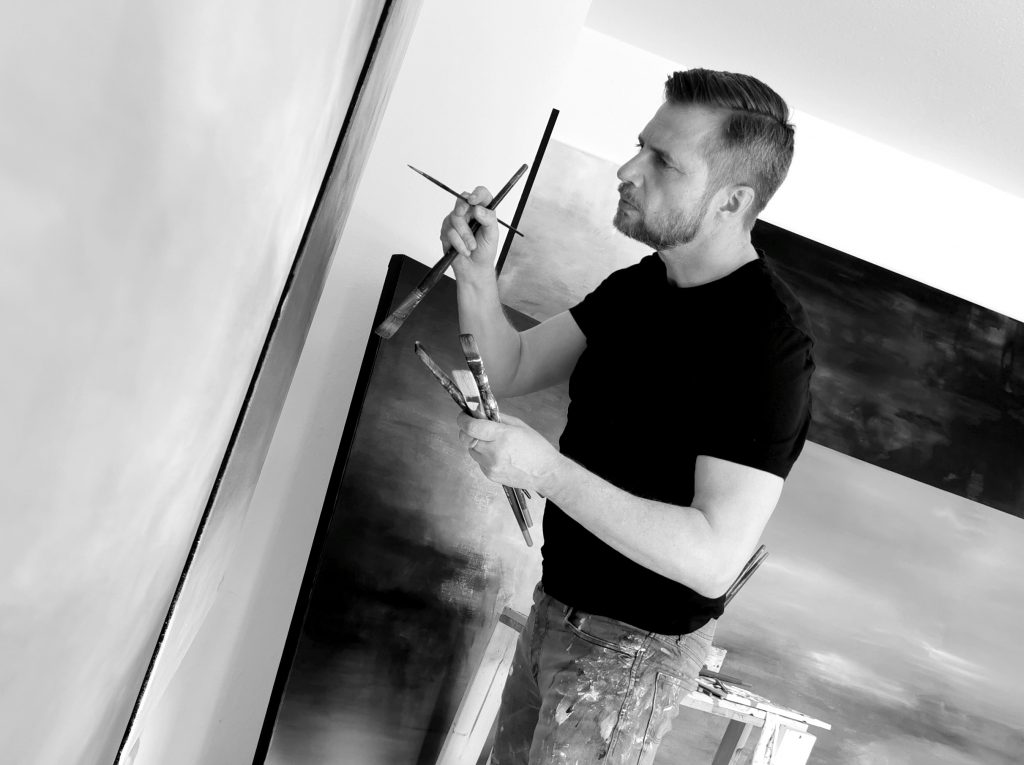
»ONLY BEAUTY WILL SAVE THIS WORLD.«
* * * * * *
Are there any key topics in your work?
Yes, from my point of view art needs a discursive content, a red thread. Paintings that do not negotiate a topic, remain dumb and inevitably speechless and lose the right to serious participation in art. In any case, I have a clear artistic theme and I talk about it. From the first inspiration to the last brushstroke, man is always at the center of my work. Nothing is more exciting, more diverse and more expressive than the human being itself. Nothing is more rewarding in the consideration because it always means self-knowledge. With the means of abstract painting, I address this everlasting human conflict between our inner and outer world. My painting is (also) a search for the human being in us. Of course, every answer I give in my work remains subjective. But the initial question touches us all the same: what is the real in and behind the supposed, surrounding reality? What and how are we really, each one of us? What (still) are we and what is just manipulation by third parties, the attempt to influence our feelings, thoughts and actions? For me, the only truth lies in our personal perception. We alone are the legitimate source of reality.
Many of your works refer to historical events or personalities from the past. Why?
We lose a part of our identity without a knowledge of history. This knowledge of our past helps to classify the present in politics and society and to separate the truths from the lies. As a result, you recognize the superficiality of our times more easily. In addition, history is full of human dramas worth to be told and to be reminded. History is a great source of inspiration for me. And it is a way to express my respect for the life achievements of earlier generations. Man and his feelings and thoughts over the centuries have changed less than we want to admit. It is worth looking back as an artist, even if it has become unfashionable to reflect on his roots. But I go my own way.
You prefer the large format. Has this preference always been there for you?
I was never afraid of the big canvas. It gives me an incredible sense of creative freedom. The boundaries in my art are reduced, the mental as well as the physical restrictions. I always wanted to paint big, be challenged by the dimensions. But mindfulness is needed. Even the smallest mistake is immediately noticed, becomes more obvious because of the size and disturbs the harmony of the painting. I love the multiple challenges standing in front of such a huge canvas and to execute what the soul dictates. In my opinion, for me as an artist, the painting cannot be big enough.
So you are dealing in your art with the individual person and with all the big and small human conflicts?
Dramas are unavoidable. There are so many personal realities and not just one truth. That’s the cause of misunderstandings, contradictions and conflicts. Man is the origin of everything that is good and of everything that is bad in this world. Therefore, I deal in my work with the individual human being and his location in the modern age. Where are the truths of past times, all the certainties and the clear paths? We live in troubled times and lost the basic trust of childhood. We stand between hope and fear, between history and now, between faith and fight. So many different biographies united and separated by passions and longings, fears and doubts. And with dramatic stories that are worth telling. I do not paint new and fictional worlds; the human being is the only center of my artistic attention. Each abstraction starts with him and his little big world, his inner kingdom, his wounded soul. I choose nature as a great metaphor. That’s the way in how I reflect on what I want to tell about people. Nature is powerful, full of inspiring light, harmony and aesthetics. Man becomes small in the face of this beauty, which he can admire, but which he will never reach. And yet there is a connection. Nature is in us. All that defines us as human beings, what lives in us and makes us sleepless, all this has its counterpart in nature and is similar to coasts, mountains, seasons, forests and oceans. And our soul is the most enigmatic of all landscapes in which we wander as seekers and interrogators. My paintings give these journeys a face. Like a chronicler they document my wanderings through the inner landscapes. No doubt this is highly emotional, and it touches me deeply. It’s personal, sometimes dark and archaic, then again romantic and hopeful. But that’s exactly how I want it in my work.
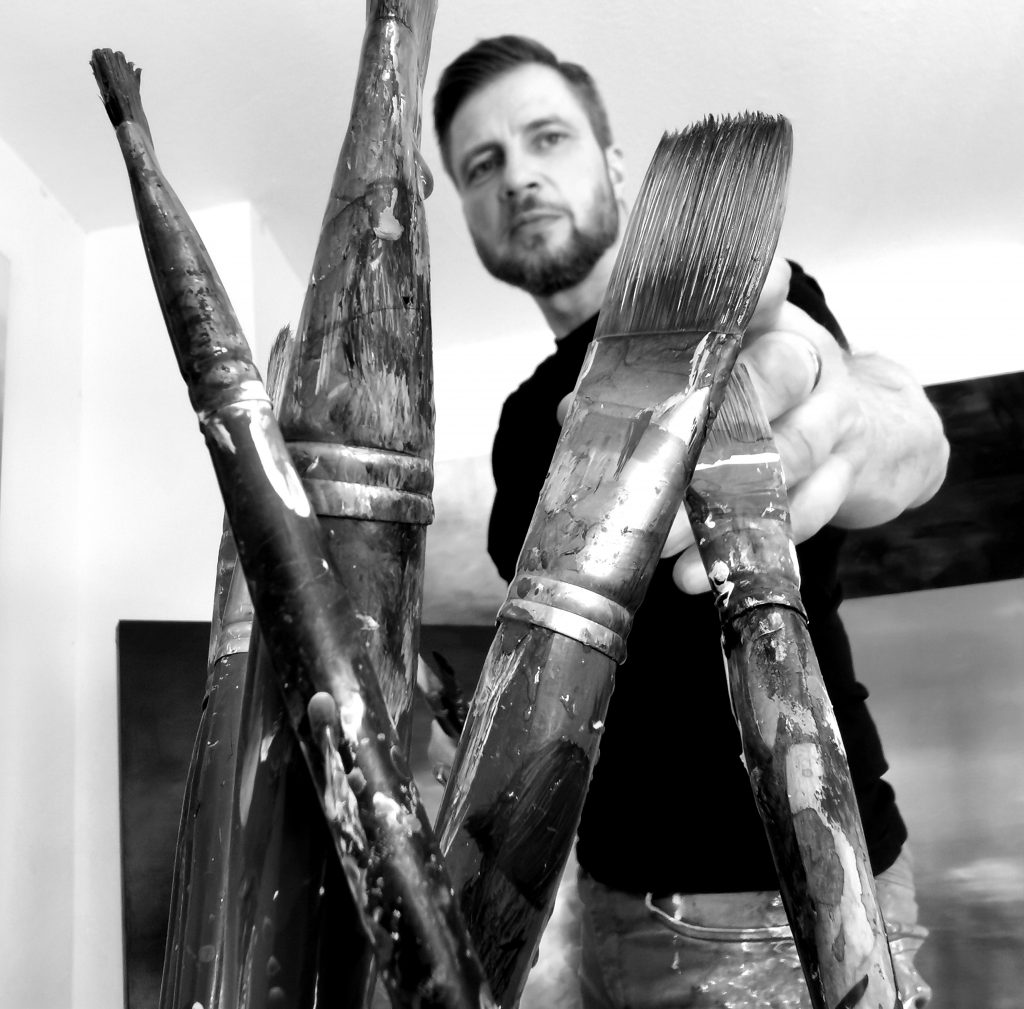
»WE HUMANS STAND BETWEEN HOPE AND FEAR, HISTORY AND NOW. THIS IS THE STARTING POINT FOR MY INSPIRATION.«
* * * * * *
You are also perceived as a German painter. Does nationality play a role in your work or for you as an artist?
Even though I do not focus on Germany in my work, it acts like topsoil on which the artistic seed matures. How could it be otherwise? Only three or four generations ago, men from my family bleed to death for the German emperor in trenches outside Verdun in France. And a few decades later, during the Second World War, my two grandfathers fought as soldiers of the German Wehrmacht on the Eastern Front, got into Russian captivity, and were released only many years after the end of the war. In the final phase of this war, as the Red Army advanced, my family were also expelled. My father’s family fled from Pomerania, my mother’s family from the Sudetenland. In the West of Germany, they then built up new livelihoods with discipline and the belief in a better tomorrow. I did not forget that. These are very German biographies whose genes I carry. Maybe this is the reason why my works are profound. This search for seriousness in a historical, reflecting context is in me.
Are you a misanthrope or philanthropist after all the time dealing with the human in your art?
I do not always endure all human unreasonableness and arrogance towards nature and genesis and all the aggressiveness and groundless megalomania. There is so much humility missing. And yet, I like people, I like their vulnerability, the empathy behind the facade, the abysses of the soul. Nobody is without guilt and without scars. But what makes us vulnerable is also our strength. In the end, it’s always about power in some way and about love as the quintessence of everything. Love can create chaos, overthrow empires or lead to paradise. Above all, love is the ultimate question and answer. That gives me hope.
You understand yourself as an emotional observer. Is there not a danger that your feelings will lead you astray? Would not greater objectivity be inappropriate?
I do not want to be a distanced chronicler of states, cynically listing all the shortcomings and feeling morally superior. I take sides with people and their passions, even if they are irrational and may lead to destruction. That’s why I allow myself a deep emotionality in my work. As a regulative, sometimes as an antipode, my strict aesthetics alone are effective. On the canvas, aesthetics has the task of visually organizing my sometimes overbearing sensations.
Your work lives from an intense, unusually straightforward aesthetic. Is this a conscious process?
Aesthetics is for me an important creative benchmark, which I apply to my work. In addition to substantive statements, I am also concerned with pleasing proportions and balance in the artistic composition. Aesthetics is part of my art concept of beauty and has nothing in common with kitsch and is also no recourse to an ideal-world symbolism. The beautiful and the aesthetic inspire and touch me and make me think creatively. We should not underestimate the importance of aesthetics. The painting may please and can still polarize, offer discussion approaches and go into depth. It is not a contradiction.
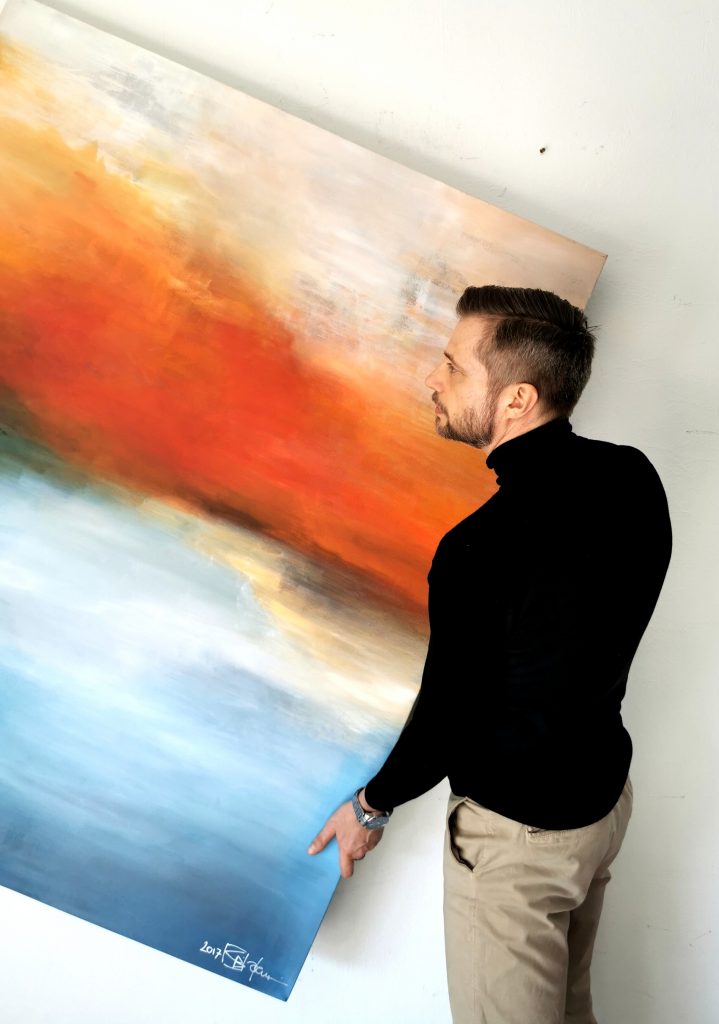
»WITHOUT THE KNOWLEDGE OF OUR HISTORY, WE LOSE OUR IDENTITY AND ALL ARTISTIC HUMILITY.«
* * * * * *
It seems contemporary art has largely departed from beauty. Does this bother you?
Some people try to convince us that contemporary art no longer needs to be beautiful, that it cannot be beautiful anymore. Bullshit. Aesthetics was and is precious. And above all, timeless. Even the unattractive or the ugly, if used consciously and pointedly, can have a certain aesthetic affect. But without inner beauty at least at second glance, without just any kind of aesthetics, there will never be art that will survive the moment. Everything else is due to a volatile trend and soon disappears again.
Are you at a distance to the modern in art?
There is this unconditional trend towards modernity. Everything must be modern, as new as possible, unconsumed and never been there in an almost impossible way. What existed so far is suddenly yesterday, out of date and obsolete. This tendency can also be observed in art, and it is like an uncritical sacrifice on the altar of the Zeitgeist. Not the quality of the work, but only the degree of modernity is decisive. But nothing is better, just because it’s modern. In most cases it is not even different. Often you notice at second glance that only old wine should be sold in new bottles.
That’s a very basic criticism. Are you afraid for the art?
There really is a lot at stake. Anyone who wants to erase what has been so far and wants to replace it with nothing but modernism, this person will not only negate their own artistic roots, but they will also ignore the cultural history of humanity. This is absurdly naive, sometimes even false. We are not viable without our history. This also applies to the art. Nevertheless, modernity has its important place for me. As something that interprets the yesterday and now in a modern, appealing garb. And here we are in my work. In this sense, I find my works very contemporary.
Man with his emotional world is the content of your work. This includes elementary topics such as birth and death. No fear of contact?
Transience is a very important topic in my work. I do not want to bother with trivialities, but to penetrate to the core and focus on the elemental. This applies equally to the nature and extent of the abstraction as well as to the content of the painting. And what could be more existential, more fundamental than the knowledge of one’s own mortality? Precisely because it is part of life, it triggers primal fears and it influences the feeling, thinking and acting of the individual. Despite all search for meaning we do not find simple answers and we must accept what the fate determines.
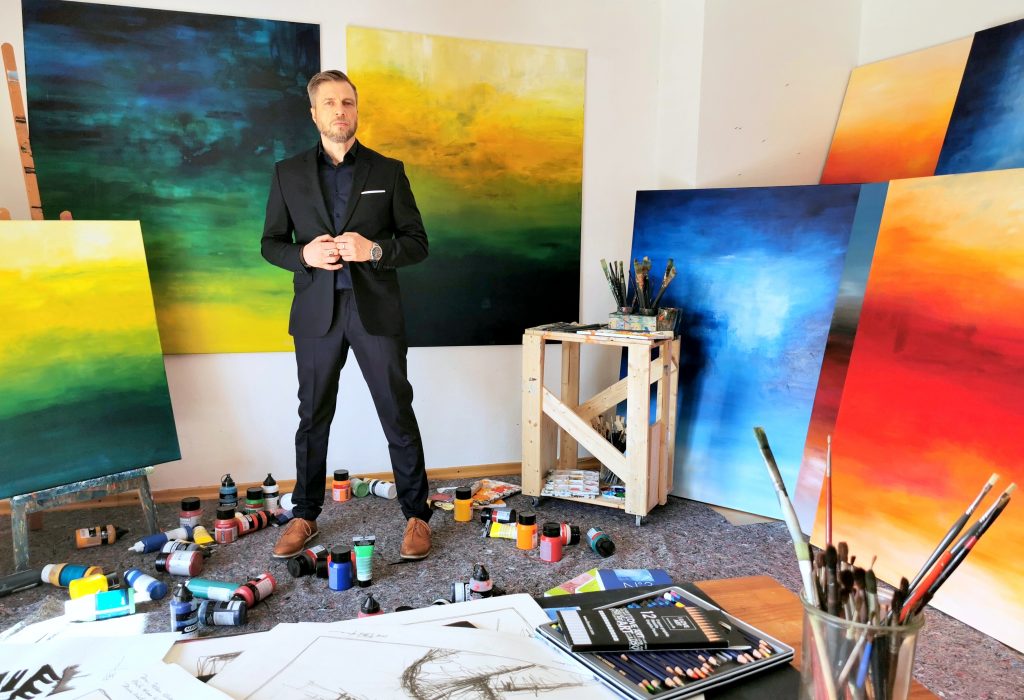
»IN THE FACE OF MY TRANSIENCE, I WOULD HAVE TO PAINT AND LIVE MUCH MORE RADICALLY.«
* * * * * *
Life as a part of the whole?
There was life before us and there will be life after us. The world has not started with us and will not end abruptly with our death. We are not as extraordinary and as exclusive as we would like it to be. It goes on and on, from the beginning to the end of time. A perpetual cycle of birth, flowering, intensity and death, both in man and in nature. A walk along the sea clears your mind. Tides and maritime elemental forces show us how tiny and vulnerable we are. That’s why I love the ocean, and that’s why the ocean is a recurring theme in my work.
Not all people want to be made aware of their own transience.
Certainly, but no one can change this irrefutable fact, even if we like to forget it in everyday life. At all times, man’s handling of his own transience has moved the artists; it is one of the great themes in cultural history. For example, I find the painting episodes of the Norwegian expressionist Edvard Munch very strong. Mortality affects everyone, precisely because it shows the fragility of our existence. We walk on uncertain ground, day after day, almost on an invisible abyss. Every predictability is illusion, more like desire than reality. Nothing is certain, even if we align our lives precisely as if we were holding our fate in our hands. So I think it’s only natural that I turn my attention to this subject in my art again and again. All fears of contact would be inappropriate.
It stands out: Your painting titles are often poetic, sometimes seem like they’re out of time. Are you a romantic?
I attach importance to emotional titles because they open an additional, intimate level of reflection for my paintings. I also like dealing with language and poetry a lot. My titles are deliberately chosen, sometimes the result of a week-long search, sometimes found in moments. There is always a reason why the painting bears this and no other title. For me, they are fragments of a very personal poem. This also applies to words that I write for some of the paintings and that capture my mood during the execution. For me, this is all part of the creative process, interdisciplinary and regardless of whether it is painting or poetry. My passion is the foundation. You may call it romantic, but I do not label it myself.
»THE HEART OF MY ART COMES FROM A PLACE WHERE THERE IS LIGHT.«
* * * * * *
You paint abstractly, so open to interpretations. On the other hand, you have a clear theme in your paintings. Is that not a contradiction?
The canon has long since fallen, this all-accepted yardstick that defined art since the Middle Ages, which determined the ability of a painter and his works to be judged. And this code fell rightly, that superficial censor, because it took every breath away and allowed only one of many ways. But what took the place of this canon? We live in a world without an artistic guideline. And if there are no limits, then everything is possible and at the same time nothing is real. That is the status today. In the unmanageable mass of the mediocre, the extraordinary threatens to sink.
Therefore you have a clear message in your abstraction?
I am not ready to accept this arbitrariness for my work. I do not want to paint irrelevant pieces; I would like to make a statement. But especially with a reduced, abstract painting, I see the danger to slip into the groundless or exaggerate the profane. And that is why I work out my positions more sharply, formulate an artistically clear theme in my paintings.
Are you not afraid of too much pathos when you discuss such fundamental questions in your work?
There are not too many thoughts and feelings when dealing with existential topics. Ultimately, there is a single question behind it: where do I come from, where do I go, and even more, what is the purpose of my existence? I’m looking for answers in my painting. As the philosopher does with words, so do I use my means as a painter.
There is a lot of melancholy. Does your work need this gravitas?
Melancholy is not bad but means that I deal with my earthly existence and with my own transience. As humans, we need these deep thoughts and the feelings that accompany them. Behind the gravitas, light and warmth are waiting for us. We need the darkness to perceive the light. No flow without ebb, no light without shadow, no day without night. And that is why it needs the heaviness and melancholy to understand life as a great possibility. My paintings live on this dialectic and the tension that grows out of it. Therefore, I also say: The dark warms and cleans, it makes you aware. And that’s why I paint from the dark into the light. Exactly that is the message in my art: Accept the continuous cycle of life as fearlessly as possible, the good as well as the bad. Live in the present, but without crippling fatalism. Fighting is allowed, fighting is important, in a positive sense and with an open visor. Better a fighter than a victim. The grandiose Welsh poet Dylan Thomas summed this up very well in a single line, this feeling of inevitability paired with resistance: Do not go gentle into that good night. A clever, multi-layered interpretation-capable sentence. The fact that he wrote the poem, from which this quote originates, for his dying father also makes it touchingly authentic. I think that’s the only right perspective to look at our lives. As an opportunity, as an experience, as an adventure. Without bitterness, even if this is sometimes difficult. Our soul persists because it is immortal. And the human element of us lives on in our memories, through our acts and words, in our children and grandchildren. The middle-aged people formed the phrase: Carpe diem et memento mori. Take advantage of the day and think about your mortality. Everything can be over soon. We really have nothing under control. It can happen to anyone at anytime. That’s the true message of life. It’s a gift, every single day, every single hour. My painting needs this gravitas.
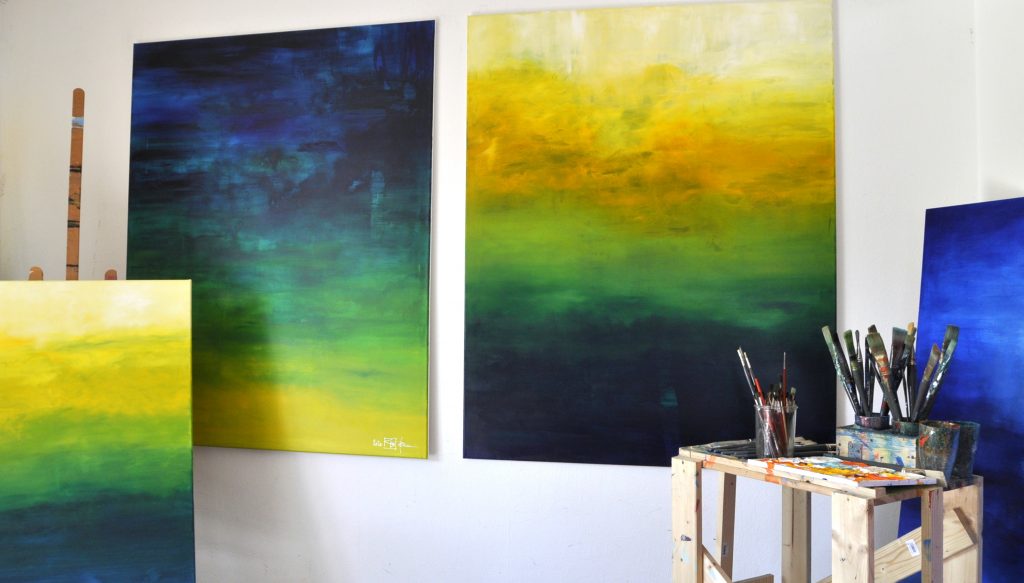
»OUR SOULS ARE MYSTERIOUS BUT WONDERFUL LANDSCAPES.«
* * * * * *
Speaking of philosophy, you once said that you do not paint as radically as you should. What is that supposed to mean?
This goes back to a saying by the Hungarian writer Peter Esterhazy: I do not live radically enough. I live as if I expect eternal existence and not total annihilation. I try to keep this fact in mind. There is no reason in my painting not to be radical in the face of the limitations of my earthly existence. But on the contrary. I should, I must try again and again, more than now. Any compromise or consideration is misplaced and leads to creative nothingness. There is so much to discover in my art. I want to challenge myself on my way, to remain risky to the utmost.
We encounter religious themes in your work. Is not this proximity to belief unusual for a contemporary painter?
I do not create religious paintings, at least not in a narrower sense. But I understand the faith as an enrichment and address it in different ways. Hope and light, love and faith are so incredibly strong, timeless human sensations, they must be part of my work. Just as much as revenge, war and death. And many biblical narratives are still suitable as a metaphor in the 21st century. Religion is important to me. There are situations in life when our models of scientific explanations and the human ratio reach their limits. But I feel a spell in this world that helps throughout the day and through the night and offers answers beyond the technocratic, sterile objectivity of our everyday lives. There is destiny and mood. I believe in God and I believe in miracles. Finally, this gives somehow a deeper meaning to the vain ego show that painting is.
Does it affect your understanding as an artist?
I have been given my creativity and artistic expression; I am convinced of that. This is not just a gift, but also a commitment. I must continue to work on myself and not waste my opportunities recklessly. I want to stay focused and outgoing on the artistic path. I do not know where it leads, but I am sure there is always a good reason for the next painting, for the next creative step.
Are there any artists that you follow?
I artistically go my own way. Nevertheless, I am in a tradition with my art. Of course. My points of reference are very different. They stretch through the past centuries to the present day and range from the Classical Modernism through Art Nouveau and Expressionism to contemporary art. I am influenced by painters like JM William Turner and his visionary color abstraction, the incredible Ernst Ludwig Kirchner, Edvard Munch for his image-like melancholy, Pablo Picasso with his creative power, even someone like Gustav Klimt and his gold-laden interpretation of Art Nouveau, the impressionist Claude Monet (just with his late work). Added to this is the work of the great abstract American painters Joan Mitchell and Helen Frankenthaler. And from the field of contemporary Neo Rauch because of his seriousness in dealing with topics, Gerhard Richter and finally Anselm Kiefer and the rough Georg Baselitz. These are the poles between which I move. Coordinates, influences, currents, nothing more, nothing less. I can get involved in all these paintings and painter lives and still go independent ways in my own art.
»I DO NOT WANT TO CREATE ART THAT CAN BE BOTH EVERYTHING AND NOTHING.«
* * * * * *
No art without inspiration. How are you inspired?
My creative process is intuitive, I largely renounce planning and sketches. I am fortunate to be rich in ideas. And they are suddenly there, unasked and sometimes at inappropriate moments. This inspiration is deep inside me. It has something meditative, if everything can flow on and off, every emotion, every thought. No censorship at this time. And my concrete ideas arise from the remnants remains on the beach after the end of the flood. My inspiration is a curse and a blessing at the same time. It drives me, does not make me relax, and craves for a perfection that can never exist.
Are you like so many painters looking for the perfect painting?
My paintings are not perfect, they cannot be perfect. I must live with the condition of the imperfect. It documents a degree of maturity, but never the final end. I have not yet painted the finished, the perfect, final painting, and to be honest I am very happy about this circumstance. I am afraid that a perfect flawlessness would also mean boredom. The end of all doubt, corners, edges and breaks. And nothing could come afterwards. This perfection would kill my painting. But I like the irresolvable contradictions in my paintings. And that’s exactly why I like the imperfect.
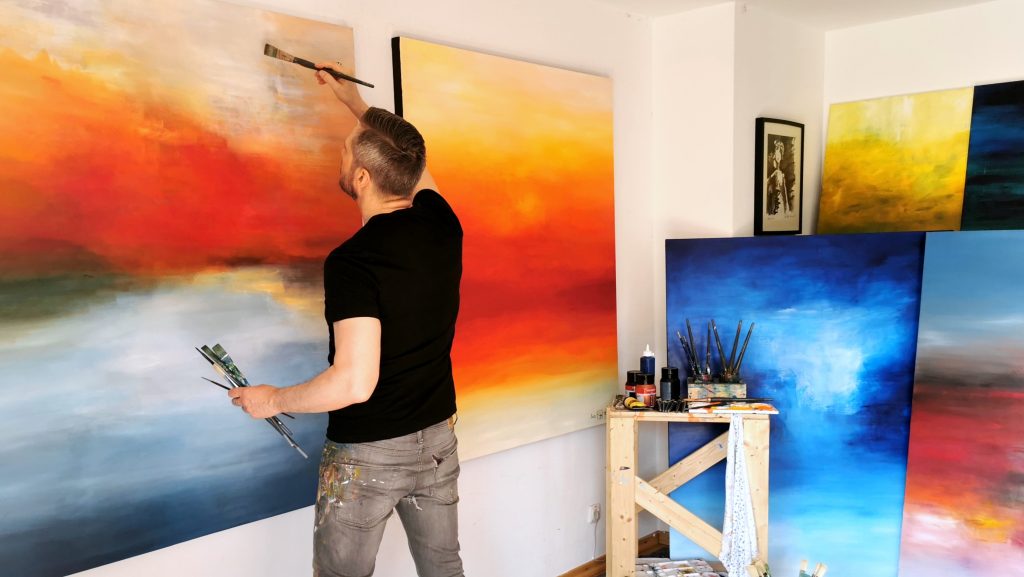
»BEYOND A CERTAIN POINT THERE IS NO RETURN. THIS POINT HAS TO BE REACHED.«
FRANZ KAFKA – this quote by the Jewish Bohemian novelist and short-story writer Franz Kafka perfectly reflects how I try to act in my art, day and night and for every single painting
* * * * * *
You say, painting is also a fight for you. Your creativity would not only need consonance. What exactly do you mean by that?
Painting is fight. Not in every minute, not exclusively, but often. A fruitful struggle with myself, an infinite struggle for colors and motives in my own dialogue. There are these days and nights, when every stroke must be fought for, when every color needs to be questioned. Of course, it’s good that it’s not all easy. Each of these struggles is worthwhile because it shows that as a painter I am still breathing and developing. This fight may hurt me intellectually and emotionally too. I like the paintings the most, that were created in such fights.
Your paintings come with a message. Do you expect the viewer of the image to follow your content?
I find that strange, because it’s not about what I see as a painter in my work. There is never only one wrong and one right. It is perfectly legitimate when the viewer develops a different perspective and challenges his own interpretation. I even ask for it. That is precisely what makes contemporary art. Good and powerful paintings are (also) projection surfaces that leave space for the thoughts and feelings of the viewers and evoke their sensations. Each one creates his own image, and none are alike. We should not pretend that paintings can be objectively viewed and reflected. The dialogue between the painting and the viewer is always intimate and highly personal. As a painter I cannot hold on to the artwork, sooner or later the moment comes, when the painting emancipates, grows out of my hand and goes its own way. This process is unstoppable. Everybody takes part in it, adding a new, own and of course equally correct interpretation. The first, the original idea blurs more and more. This is a natural process. I like letting go because there is room for new works. Every departure is also the beginning of something new and exciting. This is also true in art.
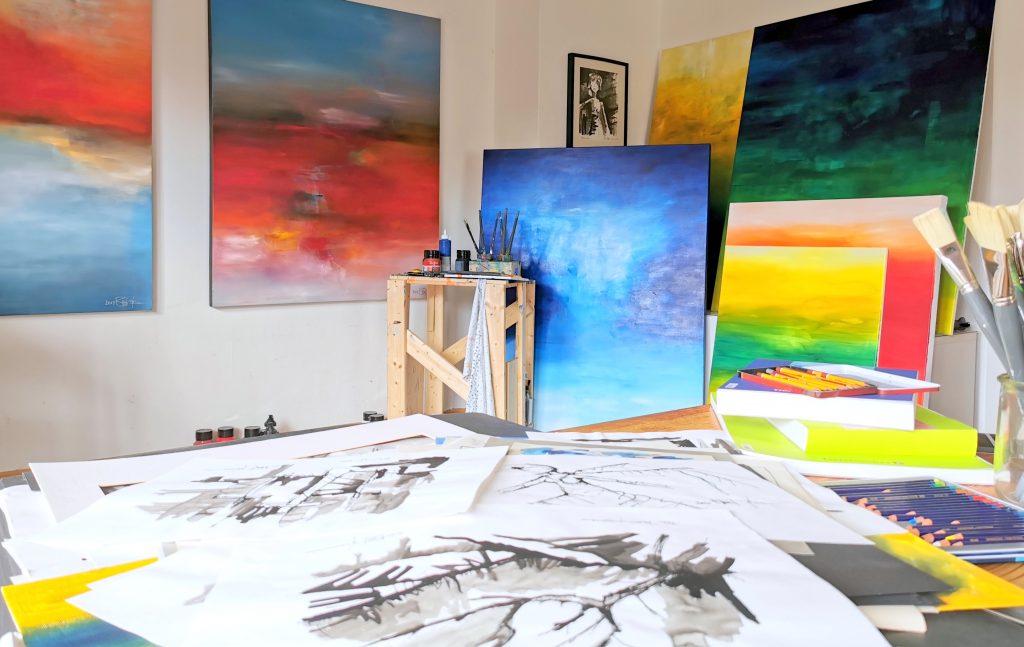
»I LIKE THE IMPERFECT IN MY ART.«
* * * * * *
You emphasize the subjective in the perception and speak not only of one but of many realities. What does that mean?
Precisely because there is not only the one, the only reality. There is no monopoly on reality. Reality is subjective and reality is exclusively in us. Each of us has their own private little reality and how they see and feel things. My reality is not your reality, it cannot be. But your reality is as right and good as mine.
Why is this statement so important to you? What significance does that have for your painting?
It is meaningful as knowledge. We trust the real, we believe it to be the truth. But we are lying. And are also lied to, deliberately manipulated. Until we finally believe in one of these realities as the universal formula for truth and as the only correct one. But this world is less secure than we think, full of different, contradictory realities, and none is truer. In my painting, I try to clarify this point of view. My style of abstraction aims to push us to the core of what really remains and represents consensus.
What significance do art theories have for you?
Unfortunately, we are dealing with art theories that explain to us ex cathedra how to interpret the work in question. This absolute interpretation claim disturbs me. I find it incomplete to interpret the creative solely with the ratio and to reduce artistic competence to a generic affiliation. Art does not do well when a theoretical, intellectual debate occupies everything. These are discussions in the ivory tower. Painting, as I live it, is a gut feeling. And above all it is heart and soul, no head-birth. It’s primarily about feelings, so let’s not talk about anything else.
Are you planning major exhibitions soon?
I no longer need a long list of venues to flatter my ego, I find it outdated in the 21st century. Nevertheless, direct contact with my audience is important to me. My collectors are mostly in the US and UK. In the future, therefore, I will show more local presence in the Anglo-American area. Specifically, exhibitions are planned in Los Angeles, New York and London.
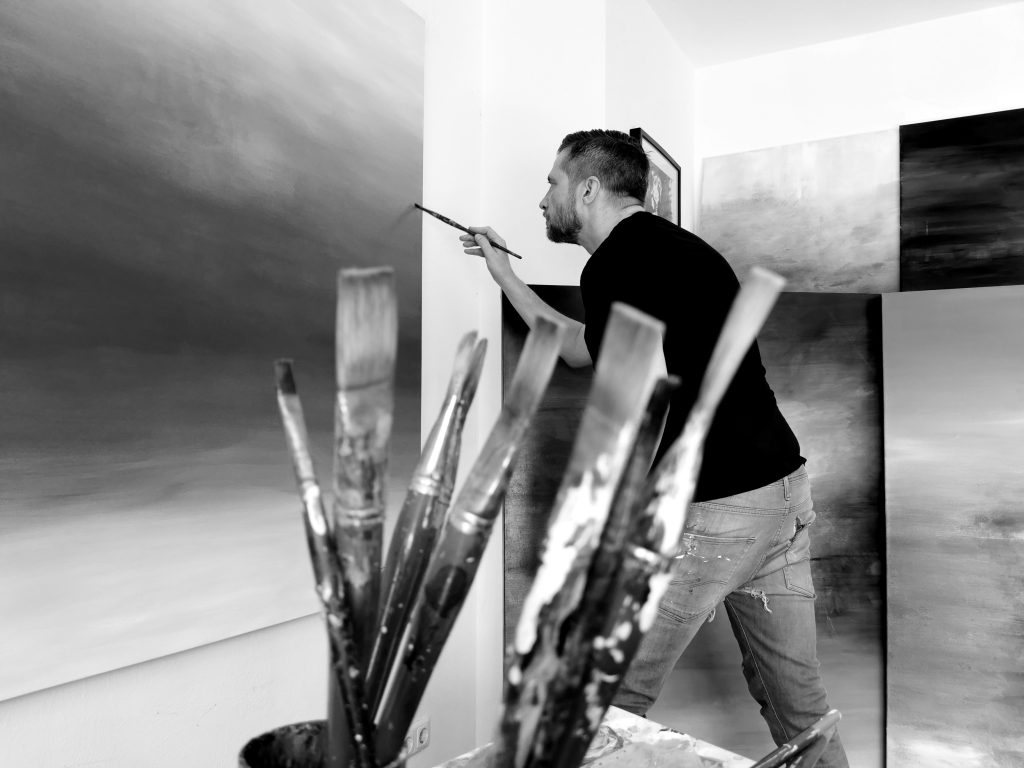
»I FEEL A LOT OF MENDACITY IN WHAT IS CALLED MODERN IN ART AND WHAT FLIRTS WITH THE ZEITGEIST.«
* * * * * *
There is more than just the art of the painter. Art also has an economic importance, is a commodity. How do you feel about this aspect?
On the one hand is my art that I create. I paint for myself; it is in me and it must come out and the painting wants to be manifested. That’s art of me and for me. Every serious artist knows what I’m talking about. So, I do not paint for any art market, but for myself. But art is also always a purchase object, financial investment and a luxury item. I am happy about each of my paintings, which arouses interest in the audience and finds buyers. It is fantastic and a great support, so that I can continue my painting at this high level. I am glad about the interest of the collectors in my work and in my person. I have had very pleasant contacts with the owners of my paintings out there in the world over the years. I like this kind of feedback. It encourages me to be on the right track. So in that sense, both aspects are part of an art I live. Painters/paintings and collectors enter a fruitful symbiosis. In addition, no one is an island, this also applies to Christian Bahr.
Are the prices on the art market sometimes not completely overdrawn?
Surely there is one or the other insanity in the art scene, and certainly not all is gold, what is market-screaming advertised. But art is also one of the few areas that is still suitable as an investment with a stable added value. This aspect has been valid for many centuries, and it is still true today. For many collectors, it is a real selling point. The art market regulates itself as a financially sensitive area over supply and demand, and I think this is traceable and legitimate.
When art comes together with capital and investors, does this not contradict the purity of painting?
Art has never been innocent. As soon as a painting leaves the studio, the price certainly plays a role. That has never been different. Art has always sought the proximity of money. But this connection has not damaged the beauty of art and its expressiveness. I cannot support the lament that art has lost its innocence. Moreover, art has never been a democracy. It is far too much a status symbol as well as an intellectual and social prestige object.
Some of your paintings are already traded in the five-digit range. Acceptable?
One may consider that I create unique pieces with lasting value and long life. My paintings are of high quality and will please people in a hundred and more years. In addition, the price that the buyer is willing to pay always says something about the respect that you have for my artwork and for me as an artist. I’m talking about esteem, and the selling price is just a reliable yardstick for that. In addition, I owe it to my paintings to seek an adequate price. I am selling a very intimate part of myself. Therefore, any price is reasonable if it can be legitimately achieved on the market.
Thank you for the interview.
Again to read: this interview as pdf-document > MY PAINTING PHILOSOPHY (PDF)
(This interview – originally in German, translated into English – is the transcript of an interview published in the fall of 2019 by cultural editors of an online magazine with Christian Bahr. The interview is also available in German as a long text and as a PDF document via the German version of this website.)
